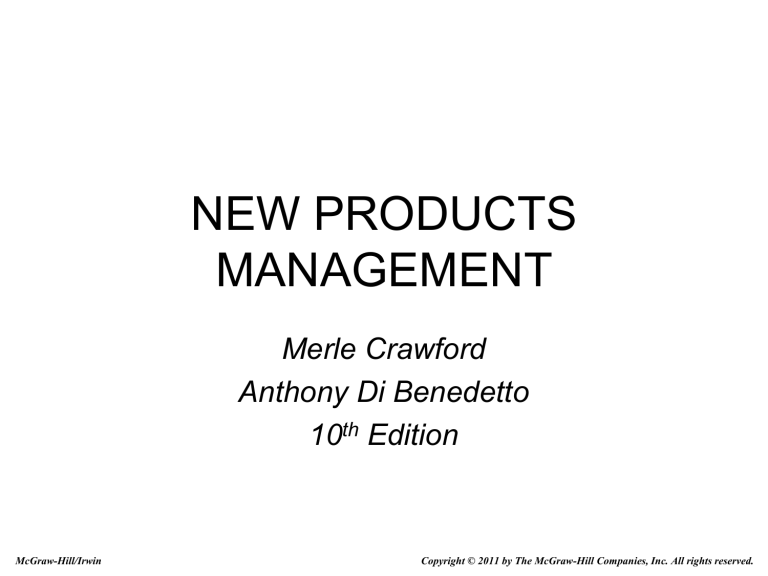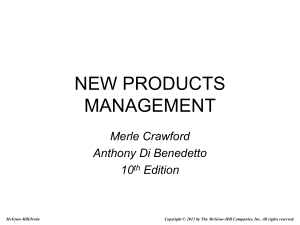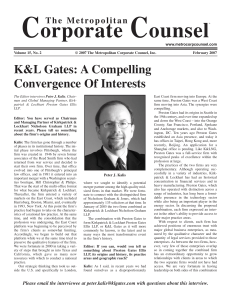
NEW PRODUCTS
MANAGEMENT
Merle Crawford
Anthony Di Benedetto
10th Edition
McGraw-Hill/Irwin
Copyright © 2011 by The McGraw-Hill Companies, Inc. All rights reserved.
PART ONE
OVERVIEW AND OPPORTUNITY
IDENTIFICATION/SELECTION
1-2
Opportunity Identification and Selection
Figure I.1
1-3
Chapter 01
The Strategic Elements of Product
Development
1-4
Why Study New Products?
• It is big business – billions of dollars annually on
technical development alone.
• The challenge of creating radical innovation
(totally new product categories) is viewed by
business consultant Gary Hamel as “the most
important business issue of our time.”
• Accelerating innovation and business growth
through innovation are the top business
challenges according to the Industrial Research
Institute.
1-5
But the New Products Process
is Difficult!
Percent of Products that Fail
90
90
80
70
60
50
40
30
20
10
0
40
10
Sometimes Quoted
in Press
Research Reports
Sometimes Claimed
Although you may hear much higher percentages, careful
studies supported by research evidence suggest that about
40% of new products fail — somewhat higher for consumer
products, somewhat lower for business-to-business products.
1-6
Best Practices in New Products
• For every 100 ideas,
– Fewer than 70 make it though initial screening
– Fewer than 50 pass concept evaluation and testing
– A little more than 30 make it through development
– About 30 make it through testing
– About 25 are commercialized
– 15 of these 25 (about 60%) are successful.
– Success rate is lower in consumer goods (51%) and
as high as 65% in healthcare.
Source: Comparative Performance Assessment Study, PDMA, 2003.
1-7
Comparing the Best New
Product Firms vs. the Rest
• For the top new product firms, about 49%
of company sales and profits come from
products that were introduced in the last
five years.
• For other firms, this average is about 21%.
• Lesson: firms that maintain their
commitment to new products are rewarded
with sales and profits!
1-8
Globalization and New Product
Development
• Top firms deploy over 50% of their R&D spending in
foreign countries.
• Global product teams allow firms to leverage their new
product skills across their subsidiaries.
• Design, R&D, and manufacturing may occur in different
subsidiaries around the world.
• Difficulties: coordinating the efforts across multiple
countries to launch a successful new product.
• Having a global innovation culture – being aware of
differences in business and cultural environments and
being open to global markets – is important to success.
1-9
Firms With a Global Innovation
Culture
• Procter & Gamble products are developed globally in
the firm’s 22 research centers located in 13 countries.
Market research and testing of the Swiffer occurred in
the U.S. and France.
• Apple did product design and customer requirement
definition in the U.S. and Japan in developing the iPod.
• Ikea identifies unmet customer needs and commissions
in-house and outsourced designers to compete for the
design. Worldwide manufacturing partners compete for
the manufacturing rights. The firm also has excellent
global logistics for product delivery to stores and
customers.
Source: Loida Rosario, “Borderless Innovation: The Impact of Globalization on NPD Planning in
Three Industries,” Visions, June 2006.
1-10
The New Products Process is
All About Teams
• The new products team is a cross-functional
team with personnel from marketing, R&D,
engineering, manufacturing, production, design,
and other areas.
• All members of the team make a contribution to
the new products process and the success of
the team depends on how well they interact.
• Try to avoid narrow functional viewpoints and
stereotypes.
1-11
Not All New Products Are Planned
•
•
•
•
•
•
•
Microwave ovens
Aspartame (NutraSweet)
ScotchGard fabric protector
Teflon
Penicillin
X-rays
Dynamite
In each case, an accidental discovery — but someone knew
they had something when they saw it!
1-12
What Is a New Product?
•
•
•
•
•
•
New-to-the-world (really-new) products (10% of new products):
Inventions that create a whole new market. Ex.: Polaroid camera, Sony
Walkman, Palm Pilot, Rollerblade skates, P&G Febreze and Dryel.
New-to-the-firm products (20%): Products that take a firm into a category
new to it. Ex.: P&G brand shampoo or coffee, Hallmark gift items, AT&T
Universal credit card, Canon laser printer.
Additions to existing product lines (26%): Line extensions and flankers
that flesh out the product line in current markets. Ex.: Tide Liquid, Bud
Light, Apple’s iMac, HP LaserJet 7P.
Improvements and revisions to existing products (26%): Current products
made better. Ex.: P&G’s continuing improvements to Tide detergent,
Ivory soap.
Repositionings (7%): Products that are retargeted for a new use or
application. Also includes retargeting to new users or new target
markets. Ex.: Arm & Hammer baking soda sold as a refrigerator
deodorant; aspirin repositioned as a safeguard against heart attacks;
Marlboro retargeted as a man’s cigarette.
Cost reductions (11%): New products that provide the customer similar
performance but at a lower cost. May be more of a “new product” in
terms of design or production.
1-13
Easier Said Than Done?
• Top innovators such as Intel and Gillette stay focused
and committed to innovation as a long-term strategic
goal.
• Without such focus, firms can fall back to “tweaking”
existing products and relying on minor product
improvements, instead of true product innovation that
results in new-to-the-world products or really new
product lines.
• The best new product firms do not give in to this
temptation, but continue to commit to innovative
products.
• The biggest factor contributing to success is having a
unique, superior product that adds value for the
customer.
1-14
The Strategic Elements of
Product Development
• The New Products Process (This chapter and Chapter 2)
– A phased process that takes the new product idea
through concept development, evaluation, development,
launch, and post-launch.
• The Product Innovation Charter (Chapter 3)
– A strategy for new products that ensures that the team
develops products in line with firm objectives and
marketplace opportunities.
• The Product Portfolio (Chapter 3)
– A way to assess which new products would be the best
ones to add to the existing line, given financial and
strategic objectives.
1-15
The Basic New Product Process
Phase 1: Opportunity Identification/Selection
Phase 2: Concept Generation
Phase 3: Concept/Project Evaluation
Phase 4: Development
Phase 5: Launch
1-16
Principles and Issues in the
New Products Process
• Between the phases of the process are evaluation tasks or
decision points, where hard Go/No Go decisions are
taken.
• There is pressure to accelerate time to market (speed the
product through this process), and phase overlapping and
cross-functional teams are used to accomplish this.
• Fuzzy gates are commonly used: this is a “conditional Go”
so as not to slow down the process in analysis.
• Still, fuzzy gates must have teeth! A potential problem is
that the result should be No Go but the project goes
through anyway.
• Another problem: hollow gates (the Go decision is made
but no financial support is provided).
1-17
Third-Generation New Products
Process
• Most firms use what is called a ThirdGeneration process.
– This is a flexible interpretation of the basic
process, which allows overlapping phases
and fuzzy gates.
• This flexibility is particularly important in
the development of new-to-the-world,
breakthrough products.
1-18
The New Products Process Interacts
With the Other Strategic Elements
• Without the strategic direction provided by the Product
Innovation Charter, the firm’s attempts at product
development will be unfocused. The PIC helps the team
identify opportunities and focus efforts.
• Product Portfolio considerations help the firm decide
whether a new product opportunity adds financially and
strategically to the current line and avoids spreading
scarce financial and human resources too thin.
1-19
So, Does All Of This Actually
Work?
• Check the efforts of the best product developers
in the business: the Outstanding Corporate
Innovator award winners as selected by the
Product Development & Management
Association
• Recent winners: Hewlett-Packard, Dow
Chemical, Maytag, Harley-Davidson, Corning,
Royal DSM, Bausch & Lomb.
• All have had a sustained commitment to
innovation, with remarkable results in terms of
new products.
1-20










